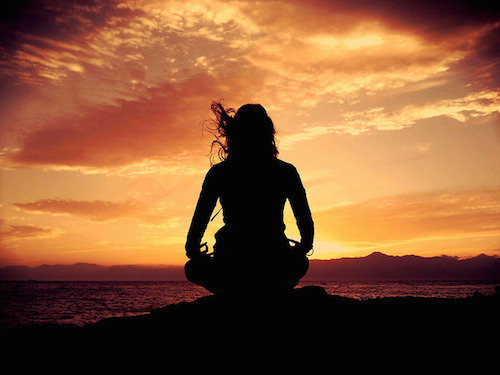In 1998, at age 18, I had the privilege of attending my first ever yoga class at Downward Dog Ashtanga Yoga Studio in Toronto.
I was relieved to discover a sacred space where patchouli and sweat-soaked hardwood were waiting to embrace me with safety and encouragement. Here, I was given permission to drift into a concealed world beneath my skin for possibly the first time ever.
Already ten years into my career as a competitive Synchronised Swimmer, I had devoted more than half of my life to my muscles, tendons, joints and heartbeat. I tolerated ceaseless pain, oozed sweat and surpassed believed physical and mental limits.
Without a doubt, I “knew” my body.
Although we trained like maniacs, prior to any important competition we were asked to sit quietly and visualize our routines. We were coached on the importance of positive thought and self-esteem in relation to success.
The question was, despite the small amount of mental development introduced to me as an athlete, how well did I contemplate the other layers my spirit?
I recall walking up the incense-saturated steps of the humble Queen St. West yoga studio, where I was easily one of the youngest attendees. I knew I was entering a community that should not be disrespected or questioned.
It has taken me seventeen years since those first days to soften into the practice that I enjoy now and I hold that word, “softness,” as medicine for my soul.
Although my journey began with deep lunges, dripping sweat, heaving breath and a constant strive to attain a position impersonating the sketches on the Asana posters, I understood that this activity was merely the exterior of a much richer sacred training.
My teachers confirmed that my developing intuitive ability required trust. Time would deliver exactly what I needed exactly when I needed it and so it was.
Time would soften suffering triggered by the deep desire to do, to act and to achieve. I was ensured that only when I stopped reaching and pulling and tugging and craving, would I be gifted the secret to self-acceptance and peace.
The early connection to my physical body coupled with a commitment to strengthen it, enabled me to vaguely understand where I was headed. The common, yet elusive word”‘yoga” does not solely reference the physical in its nature. It labels a practice that asks me to explore my relation to the world and to review my misunderstanding that I am somehow separate from it.
Over the past 17 years I have hurt and healed my body.
I have studied aspects of my character and behavior that I never thought to examine prior—aspects that have allowed me freedom from past negative events, stories that are outdated and I can leave where they began.
I found the courage to become a yoga teacher, moved to the opposite side of the world, ended a beautifully safe romantic relationship, followed my dream to work in Africa and dedicated my life to connecting with people, helping them to heal themselves—all whilst walking to the beach with my surfboard in hand.
So why now, after watching yoga quietly tiptoe into society over the past twenty years attempting to lift us, humanity, from our shells of worry, indulgence, low self-esteem and superficiality are we suddenly inundated by handstands?
To be honest, is it only me who notices a daily sea of “yoga leaders” repeatedly flaunting their expertise by standing on their hands?
When did standing on our hands become yoga’s trademark?
Please, let me clarify, I am not reducing the potential blissful joy experienced when hanging upside down. I did, after all, spend twelve years of my life practicing “upside-down-ness” in a pool just for the joy of it.
I sense, however, there is a confusing message seeping onto our mobile screens—to fully experience yoga must we really bend and appear a certain way? I am confused. For me this ostentation opposes what my precious yoga practice has established.
This extraordinary practice enables me to connect with my entire body, (my bones, my heart, my thoughts) so barriers no longer exist between my skin and the air that makes it bead with sweat.
Yoga allows me to drift into a peaceful state of consciousness whereby everything is quiet and I can feel you, the person next to me not as a separate being but an extension of my sweaty arm and because of this I can understand you and empathize with you and I have the patience to listen to you and I don’t compare myself to you because we are just the same.
We are all exactly the same. Your skin may be green and mine may be pink and when I close my eyes I can feel your heartbeat and listen to your thoughts too.
Although I still contradict myself by desiring to feel the joy of a limitless floating handstand in my practice, I do not feel it defines my relationship to this beautiful sacred tool that has drifted into my life and allowed me to express myself in full love.
To all of those who feel in anyway intimidated by the handstand yoga world surrounding us, do not fret!
Go sit on the grass and close your eyes and feel the breeze brush your hair across your face and listen to the waves and the bark of a dog and the small child crying for his mother and feel your heartbeat in your big toes and know that you have advanced just as far as any upside-down “yogi,” for in this brief moment you can feel and hear everything that connects us—everything is quiet.
To me, this is yoga.
Relephant:
How to Practice Yoga Every Damn Day.
Author: Lisa Clark
Apprentice Editor: Brandie Smith/Editor: Catherine Monkman
Photo: Giuseppe Chirico/Flickr












Read 2 comments and reply